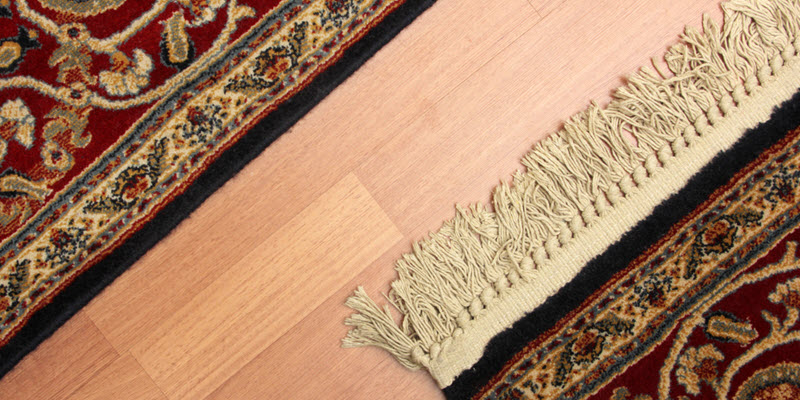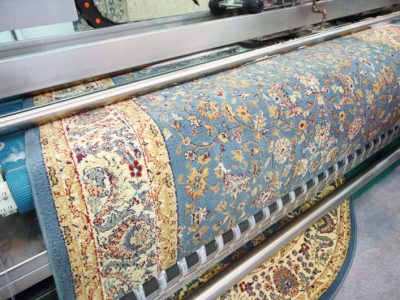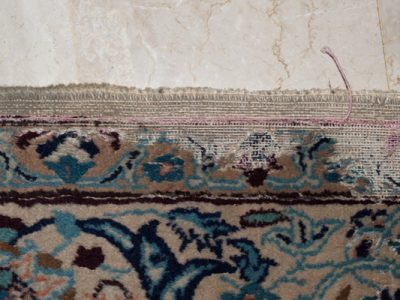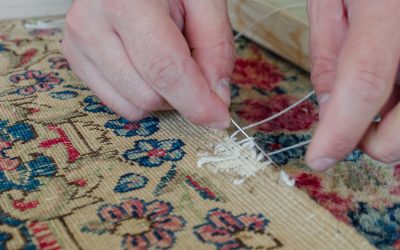Persian Rug Repair & Restoration
Home » Oriental Rug Repair » Persian Rug Repair

Smart Choice is a team of professionals with extensive experience in offering rug repair and restoration services. Their excellent quality in protecting and repairing rugs will reverse the damage and restore its appeal. The weaver will tighten up the threads and repair knots if damaged. They have experience in repairing all types of materials and maintaining rugs in their original form. So, if your Persian rug is damaged due to moths, water flooding, or any other reason, and you need a professional repair and restoration service, contact us.
Table of Contents
Persian Rug Repair Process
There are various steps to repair Persian rugs:
- To restore a Persian rug’s original quality, it is essential to search for the exact material. While repairing the tears and holes, a professional team will find the exact match and begin the repairing process.
- The technician will place the rug on the board and inspect all the damage.
- Experts repair the fringes and straighten the rug, returning it to its original shape.
- If there are holes and tears on the rug, the weaver will reweave the threads and add new fringes to maintain the quality. Furthermore, they will stitch the damaged part of the rug with matching material.
- Once the team finishes the restoration process, they will re-color, wash, and dry the rug back to its original form.
Persian Rugs
Do you enjoy decorating your home with aesthetically pleasing rugs? Then discussing rug material and originality might interest you. Obviously, rugs are incredible decoration pieces that can transform your room by enhancing the style and hiding imperfections. For instance, traditional Persian rugs feature classic designs that evoke emotions with bright patterns. These rugs are made with careful attention and intricacy. Besides offering amazing value on investment, these rugs provide benefits such as durability and longevity.
Persian rugs are the product of an art form that hails from ancient Iran. These rugs have a long history dating back to 500 B.C. The advanced weaving techniques of these Pazyryk carpets are the oldest carpet in the world. Currently, the biggest exporters of Persian rugs are Iran, Turkey, Pakistan, Russia, Nepal, and Tibet. The reason for the popularity of these rugs is the color, design, weave, and size. Because of the different weaving styles and techniques, people refer to these rugs by the name of the tribes, villages, and towns.
Manufacturing hand-made Persian rugs require the use of effort and skills. The process of weaving a Persian rug is as follows:
- This technique requires different colors of high-quality wool.
- Experts now create a design by color-coding every knot. This accurate template helps the weaver design the exact pattern.
- After forming a design, an expert weaver will start the process by setting up a loom. Weaving a traditional rug takes a lot of time because they must maintain the quality with the correct knot count.
- A professional will clip it into various sizes after removing the Persian rug from the loom. This clipping process will give the rug a recognizable look.
- To hold the foundation of the rug manufacturer will tie all the fringes together.
- Now the manufacturing team will work on the beauty of the rug by cutting the edges, washing, and drying the Persian rug.
1. Fringe Repair
Fringes are the hardest part to clean because they hang around the corners of the rug. As fringes hold the entire foundation of a Persian rug, broken fringes cause the rug to loosen up. Many rug owners do not know how to repair and clean fringes. Therefore, they prefer consulting a professional to avoid any further damage.
Pets, vacuum cleaners, and foot traffic are major reasons fringes suffer from damage. Similarly, hard bleach cleaning damages fringes as well. When your Persian rugs fringes wear away, untie, or tear off, seek out a professional’s help, or the weave will unravel. Damage to the fringes is an early sign of permanent damage because they hold the foundation altogether.
Sometimes, hard cleaning can damage your fringes, but if you choose a professional team to clean and inspect your rug, they will offer complete care. Professionals, such as Smart Choice Carpet, have the skills to clean tassels without damaging the foundation. So, hiring a professional team at the right time will save you a lot of money, sustaining the value of a Persian rug.
Professional teams have the knowledge and tools to untie knots and re-knot fringes, securing the rug before it is too late. They have special techniques to stitch and tie a rug without affecting the quality. The overcast processes prevent the rug from unraveling. Fringe repairing is an expert-level thread replacement technique that requires special skills and close attention.
2. Color Restoration
Persian rugs offer lifetime durability, all thanks to their high-quality craftsmanship. These rugs are amazing but expensive. Because craftspeople spend a lot of time and effort handmaking these masterpieces using 100% natural material, the high prices of these Persian rugs are worth it. But once you purchase an expensive Persian rug, it is essential to maintain its quality. Despite offering lifetime durability, their color might fade with time. However, you can take some measures to maintain the color, effectively slowing down the fading process.

Exposure to ultraviolet light is a common reason why rugs fade. Besides ultraviolet rays, no other spectrum damages the rug. Therefore, it is necessary to keep your Persian rug away from UV light. For instance, many rugs have bright and faded patches. This inconsistency of the colors is because only a few sections of the rug are exposed to UV light. This happens when you place your rug at an angle that the sunlight entering the room only falls on a certain part of the rug.
Knowing that the main cause of a faded rug is sunlight, you can change the direction of the rug. Whether you own synthetic or natural dyed rugs, they will suffer from exposure to sunlight. When you notice early signs of fading, immediately consult a professional rug cleaning service for color restoration. Here are some steps to prevent the color from fading:
- The first step would be to inspect the rug by immersing it in a hot water tub. Soak both sides in water for better evaluation.
- If you notice the color running, you can use a dye lock solution or dye stabilizer to colorfast your Persian rug.
- Keep the curtains closed to prevent harsh UV rays from affecting your rug.
- Consult a professional rug repair and restoration service, and they will help you restore the color of your rug back to its original condition.
3. Rug Reweaving
Rug reweaving is a technique to repair damage such as tears, burns, rips, and holes. Also, when the fringes untie, and the rug unravels, you can seek a professional to reweave the rug. Maintaining a damaged rug can be tough, especially when the weave starts unraveling. Therefore, many rug owners throw away precious and expensive rugs without considering repairs. If you want to return your rug to its original condition, you should consider reweaving.
Reweaving is a lengthy process depending on the design and fiber density of the rug. A professional will carefully connect new cords with the old warps and wefts. It is necessary to reweave your Persian rug over time because moths, broken tassels, sunlight, and heavy foot traffic can damage the weaves of your valuable rug. So, by choosing an expert team who has restoration knowledge and skills, you will enhance the value and quality of your Persian rug.
The technicians will begin the process by cleaning the threads from the spoiled region. They will gather similar color threads and start by sewing the foundation. Matching the texture and color is not an easy task and requires an experienced repairer. Hiring a professional team will help maintain the uniqueness of your Persian rug and sentimental values. Furthermore, if the repair team works proficiently, you will find the results astonishing.
4. Water Damage Repair
Floor damage, ceiling leakage, and water seepage can water damage your Persian carpet. If you identify water damage to the carpet within 48 hours and the water is clean, cleaning the rug at home will be easy. However, if black or greywater damaged your rug, consult professional rug cleaning and restoration services. Before repairing the rug, professionals will confirm the time and contamination level. Unsanitary water includes various organisms that infect rugs and cause health issues. Read the following steps to repair water damage.
- Minimize physical damage by extracting the water.
- Remove mold, bacteria, and mildew.
Identify the sections of your Persian rug with water damage. Remove items affected by accumulated water. Sanitize the floor to prevent a bad smell. - Deodorize and clean the water-damaged area of the rug. Mold and bacteria enter the fibers. Therefore, you need to clean the rug carefully.
- Now, dry out your rug with a high-speed fan, vacuum devices, and hang it in the open air. To prevent mold from growing on the rug, speed up the drying process.
- Steam the rug once it dries out. Steaming will remove the odor and completely sanitize till in-depth.
Cleaning a water-damaged Persian rug requires professional tools and equipment, especially when the damage is difficult to remove. Therefore, hire a professional rug cleaning and restoration service. They will visit your home and inspect the damage before beginning the water damage restoration process. Furthermore, they will sanitize the carpet from bacteria and mold. Eliminating odors is a highly difficult part of restoring the Persian rug from the effects of water damage. But with the help of a highly experienced team, you can enjoy peace of mind.
5. Moth Damage Repair
Moth damage is the main issue for Persian rug owners. It is unfair to throw your Persian rug due to moth damage once you have spent a lot of money. Moths can easily lay eggs on your rug when you store them in your basement, under heavy furniture, and in garages. When eggs turn into larvae, they feed on wool, damaging your rug. This can be devastating as they can quickly eat a large portion of your high-quality rug.

You may wonder how you can repair a large chunk of the piece from your rug. Well, you can hire a professional rug care team to return the rug to its original condition. After you contact rug repair services for the restoration process, they will inspect the damage. They will reweave the damaged part, maintaining the design and quality of the rug. Before stitching back, the threads, they will thoroughly and deeply clean the rug. Because larvae usually hide inside the knots and threads of the rugs, professionals remove all traces via a cleaning process.
However, it is possible to avoid moth damage in Persian rugs. You should identify the warning signs and keep the area around the rug clean. Here are some signs of moths in your home:
- Spiderweb-like substance around your carpet
- Small holes in the foundation
- Small cocoons appear on the rug
- Spots or missing pile on the rug
If you notice any similar problems, contact a professional rug cleaning and restoration service. They will clean the rug by removing eggs and larvae. Also, they will fix the damaged part of the rug using a reweaving process. If you do not notice any damage to the rug but find the presence of larvae, you should vacuum the rug from both sides.
6. Blocking and Stretching
Your rug may wrap and wrinkle due to many reasons such as tearing, pulling, and poor cleaning technique. For instance, when half of the Persian rug is under the table, and the remaining part is in an area with high foot traffic, the weaves and knots might pull out. This affects the shape of the rug. Professional blocking and stretching techniques require industrial equipment and a lot of time.
Blocking is a process that involves restoring the shape of the Persian rug. After some time, due to the placement of the rug, the shape of the rug will face distortion. A technician, while performing the blocking technique, will hang the rug on the blocking board. They will keep the edges of the rug straight and corners at the right angle to avoid any further damage. To achieve the best result, the rug should be in a blocked position for almost four days. A professional rug restoration team will follow these steps to perform a high-quality blocking and stretching process:
- First, they will brush the rug pile with their hands. They will brush the rug until it smoothens and flattens out.
- Then, tightly roll the rug from the edges.
- After a while, they will unroll the rug and keep it straight. They will repeat the process multiple times.
- Now with the help of specialized tools, they will remove the wrinkles. The tool will exert pressure on the rug at a suitable temperature. The movement of the tool should be in a specific direction to avoid any further damage.
- Sometimes, corners still curl up. In that case, technicians will use heavy objects to flatten the rug completely.
If you are looking for a team to restore your Persian rug and bring back the original quality, contact Smart Choice Carpet. Using advanced techniques and appropriate equipment, our highly qualified team will maintain the structure of your rug.
7. Overcasting & Stitching
Overcasting and stitching is a procedure to sew the fringe ends. When the knots start wearing out, a professional rug repair and restoration service will prevent further damage through stitching and overcasting. During this process, an expert weaver will ensure that the stitching is not visible on your Persian rug. Their main purpose is to tighten up the threads and protect the rug’s fringe ends from wear and knotting.

The edges of the rugs start to wear out because of consistent foot traffic. This can cause Persian rugs to unravel because of loose threads. Immediately contact a professional tea once you notice the early signs of unraveling. If you do not treat your valuable Persian rug in time, the re-wrapping process will become more challenging.
During the overcasting process, the technician will keep the stitch close to the weft on the edges. Therefore, this technique is helpful when your rug’s fringes start to wear, and the knots came off.
Submit your review | |
1 2 3 4 5 | |
Submit Cancel | |
The intelligent staff from Smart Choice Carpet worked effectively on my Tabriz Persian rug! They're exceptionally capable and friendly, as well. It was brilliant working with them. Much obliged!
Worked really hard of cleaning our Cashmere handmade rug. The entire repairing cycle was consistent with them getting it on a Sunday which was advantageous for me and dropping it off. The staff from Smart Choice Carpet ensured I was content with the cleaning before they left. Certainly, suggest him for your rug repair needs!
Happy with the service given by Smart Choice Carpet. The whole interaction of having our rugs cleaned went easily. The crew is soft-hearted and educated and I anticipate supporting and working with the organization again.
Just got my 30 years old rug back from being cleaned & re-woven by Smart Choice Carpet and it's so delicate and very much like new! I will definitely hire them again.